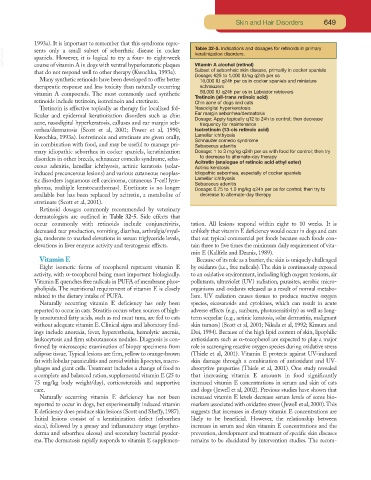Page 627 - Small Animal Clinical Nutrition 5th Edition
P. 627
Skin and Hair Disorders 649
1993a). It is important to remember that this syndrome repre- Table 32-5. Indications and dosages for retinoids in primary
VetBooks.ir sents only a small subset of seborrheic disease in cocker keratinization disorders.
spaniels. However, it is logical to try a four- to eight-week
Vitamin A alcohol (retinol)
course of vitamin A in dogs with ventral hyperkeratotic plaques
that do not respond well to other therapy (Kwochka, 1993a). Subset of seborrheic skin disease, primarily in cocker spaniels
Dosage: 625 to 1,000 IU/kg q24h per os
Many synthetic retinoids have been developed to offer better 10,000 IU q24h per os in cocker spaniels and miniature
therapeutic response and less toxicity than naturally occurring schnauzers
vitamin A compounds. The most commonly used synthetic 50,000 IU q24h per os in Labrador retrievers
Tretinoin (all-trans retinoic acid)
retinoids include tretinoin, isotretinoin and etretinate. Chin acne of dogs and cats
Tretinoin is effective topically as therapy for localized fol- Nasodigital hyperkeratosis
licular and epidermal keratinization disorders such as chin Ear margin seborrhea/dermatosis
Dosage: Apply topically q12 to 24h to control; then decrease
acne, nasodigital hyperkeratosis, calluses and ear margin seb- frequency for maintenance
orrhea/dermatosis (Scott et al, 2001; Power et al, 1990; Isotretinoin (13-cis retinoic acid)
Kwochka, 1993a). Isotretinoin and etretinate are given orally, Lamellar ichthyosis
Schnauzer comedo syndrome
in combination with food, and may be useful to manage pri- Sebaceous adenitis
mary idiopathic seborrhea in cocker spaniels, keratinization Dosage: 1 to 3 mg/kg q24h per os with food for control; then try
disorders in other breeds, schnauzer comedo syndrome, seba- to decrease to alternate-day therapy
Acitretin (analogue of retinoic acid ethyl ester)
ceous adenitis, lamellar ichthyosis, actinic keratosis (solar- Actinic keratosis
induced precancerous lesions) and various cutaneous neoplas- Idiopathic seborrhea, especially of cocker spaniels
tic disorders (squamous cell carcinoma, cutaneous T-cell lym- Lamellar ichthyosis
Sebaceous adenitis
phoma, multiple keratocanthomas). Etretinate is no longer Dosage: 0.75 to 1.0 mg/kg q24h per os for control; then try to
available but has been replaced by acitretin, a metabolite of decrease to alternate-day therapy
etretinate (Scott et al, 2001).
Retinoid dosages commonly recommended by veterinary
dermatologists are outlined in Table 32-5. Side effects that
occur commonly with retinoids include conjunctivitis, tation. All lesions respond within eight to 10 weeks. It is
decreased tear production, vomiting, diarrhea, arthralgia/myal- unlikely that vitamin E deficiency would occur in dogs and cats
gia, moderate to marked elevations in serum triglyceride levels, that eat typical commercial pet foods because such foods con-
elevations in liver enzyme activity and teratogenic effects. tain three to five times the minimum daily requirement of vita-
min E (Kallfelz and Dzanis, 1989).
Vitamin E Because of its role as a barrier, the skin is uniquely challenged
Eight isomeric forms of tocopherol represent vitamin E by oxidants (i.e., free radicals).The skin is continuously exposed
activity, with α-tocopherol being most important biologically. to an oxidative environment, including high oxygen tensions, air
Vitamin E quenches free radicals in PUFA of membrane phos- pollutants, ultraviolet (UV) radiation, parasites, aerobic micro-
pholipids. The nutritional requirement of vitamin E is closely organisms and oxidants released as a result of normal metabo-
related to the dietary intake of PUFA. lism. UV radiation causes tissues to produce reactive oxygen
Naturally occurring vitamin E deficiency has only been species, eicosanoids and cytokines, which can result in acute
reported to occur in cats. Steatitis occurs when sources of high- adverse effects (e.g., sunburn, photosensitivity) as well as long-
ly unsaturated fatty acids, such as red meat tuna, are fed to cats term sequelae (e.g., actinic keratosis, solar dermatitis, malignant
without adequate vitamin E. Clinical signs and laboratory find- skin tumors) (Scott et al, 2001; Nikula et al, 1992; Kimura and
ings include anorexia, fever, hyperesthesia, hemolytic anemia, Doi, 1994). Because of the high lipid content of skin, lipophilic
leukocytosis and firm subcutaneous nodules. Diagnosis is con- antioxidants such as α-tocopherol are expected to play a major
firmed by microscopic examination of biopsy specimens from role in scavenging reactive oxygen species during oxidative stress
adipose tissue.Typical lesions are firm, yellow to orange-brown (Thiele et al, 2001). Vitamin E protects against UV-induced
fat with lobular panniculitis and ceroid within lipocytes, macro- skin damage through a combination of antioxidant and UV-
phages and giant cells. Treatment includes a change of food to absorptive properties (Thiele et al, 2001). One study revealed
a complete and balanced ration, supplemental vitamin E (25 to that increasing vitamin E amounts in food significantly
75 mg/kg body weight/day), corticosteroids and supportive increased vitamin E concentrations in serum and skin of cats
care. and dogs (Jewell et al, 2002). Previous studies have shown that
Naturally occurring vitamin E deficiency has not been increased vitamin E levels decrease serum levels of some bio-
reported to occur in dogs, but experimentally induced vitamin markers associated with oxidative stress (Jewell et al,2000).This
E deficiency does produce skin lesions (Scott and Sheffy, 1987). suggests that increases in dietary vitamin E concentrations are
Initial lesions consist of a keratinization defect (seborrhea likely to be beneficial. However, the relationship between
sicca), followed by a greasy and inflammatory stage (erythro- increases in serum and skin vitamin E concentrations and the
derma and seborrhea oleosa) and secondary bacterial pyoder- prevention, development and treatment of specific skin diseases
ma. The dermatosis rapidly responds to vitamin E supplemen- remains to be elucidated by intervention studies. The recom-

